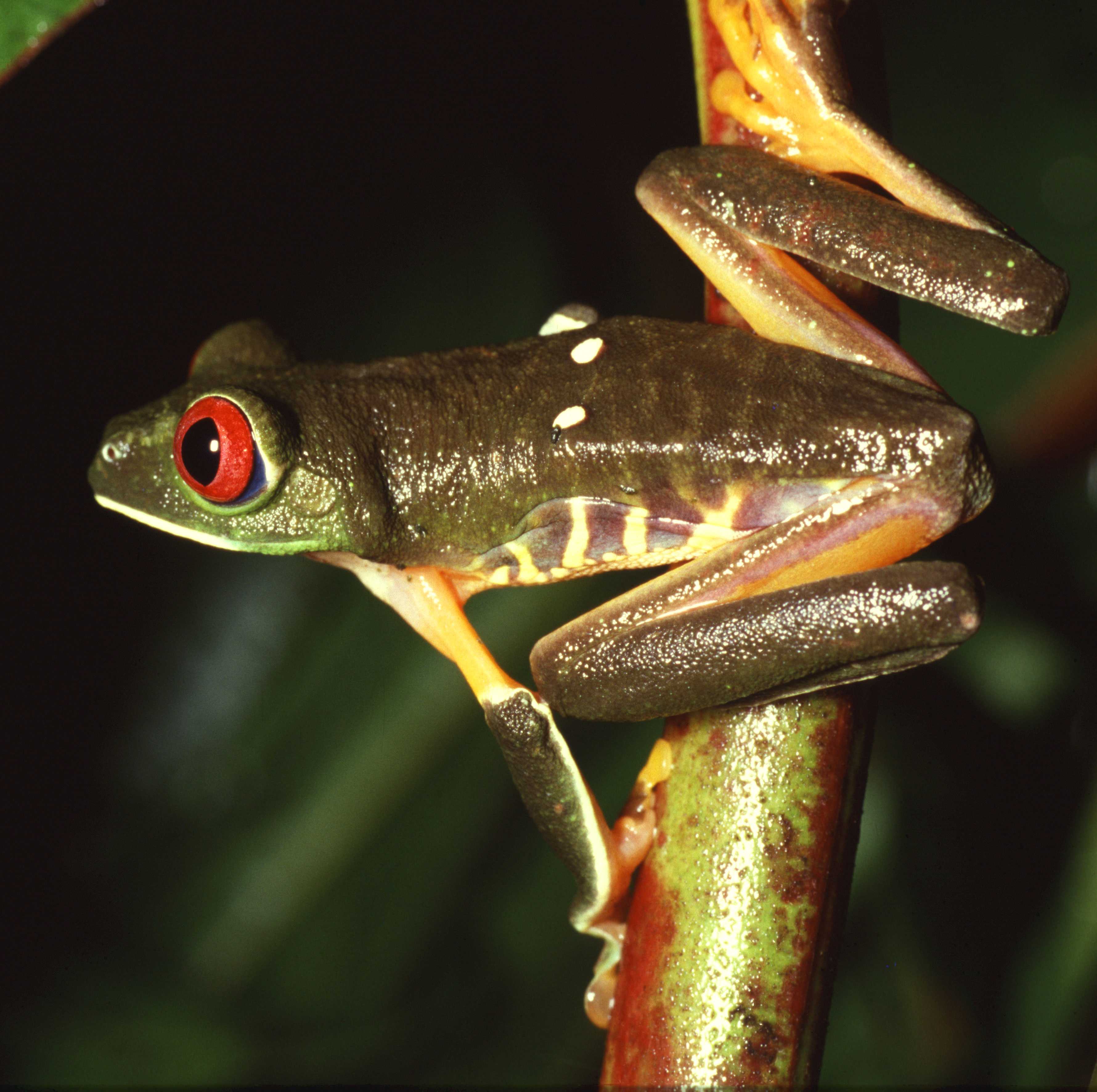- Agalychnis callidryas
Taxobox
name=Red-eyed Tree Frog
status = LC | status_system = IUCN3.1
trend=down
regnum=Animal ia
phylum=Chordata
classis =Amphibia
ordo=Anura
subordo=Neobatrachia
familia=Hylidae
genus="Agalychnis "
species = "A. callidryas"
binomial="Agalychnis callidryas"
binomial_authority=Cope,1862 The Red-eyed Tree Frog ("Agalychnis callidryas") is an
arboreal hylid native toNeotropical rainforests inCentral America .Description
The Red-eyed Tree Frog is a small-sized
tree frog , reaching lengths of about 5 - 7 centimeters (3 inches). Its dorsal surface is green of varying shades, and its ventral surface is white. The sides of the frog are purple or blue, with vertical white stripes and orange toes. Young frogs are typically brown in color and turn greener as they mature, although adult frogs can change their color depending on mood and environment. [cite web|title=Agalychnis callidryas|work=Animal Diversity Web|publisher=University of Michigan Museum of Zoology|url=http://animaldiversity.ummz.umich.edu/site/accounts/information/Agalychnis_callidryas.html] Both females and males have bulging orangy red eyes with vertically narrowed pupils, resembling the eyes of domestic cats. Red-eyed tree frogs have soft, fragile skin on their belly, and the skin on their back is thicker and rougher.Bright markings along the sides and limbs reduces predation. Most animals that prey on "A. callidryas" (some bats, snakes, and birds) often rely on their vision. When the frog moves to avoid the predator the bright colorations flash into view (hence their name, flash colors) and throw off the predator. This is achieved by leaving a ghost image in the visual field of where the frog was originally. This confuses the predator and gives the frog time to hide. These flash colors may also deceive predators by making the frog appear poisonous.
Red-eyed tree frogs are not poisonous and rely on camouflage to protect them. During the day, they remain motionless, cover their blue sides with their back legs, tuck their bright feet under their belly, and shut their red eyes. Thus, they appear almost completely green, and well hidden among the foliage. Their eyes seem to glow in the dark.
Diet
Red-eyed tree frogs are mainly insectivores. They prefer crickets, flies, grasshoppers and moths. Sometimes, they will eat smaller frogs. For froglets, fruit flies and pinhead crickets are the meals of choice.
Threats
The following have been listed as threats to the survival of the species: [IUCN2006|assessors=Solís "et al"|year=2004|id=55290|title=Agalychnis callidryas|downloaded=12 May 2006]
*Habitat Loss/Degradation - Agriculture - Crops - Shifting Agriculture
*Habitat Loss/Degradation - Agriculture - Crops - Small-holder farming
*Habitat Loss/Degradation - Agriculture - Crops - Agro-industry farming
*Habitat Loss/Degradation - Agriculture - Livestock - Small-holder
*Habitat Loss/Degradation - Agriculture - Livestock - Agro-industry
*Habitat Loss/Degradation - Extraction - Wood - Clear-cutting
*Habitat Loss/Degradation - Infrastructure development - Human settlement
*Pollution (affecting habitat and/or species) - Land pollution - Agriculture
*Pollution (affecting habitat and/or species) - Water pollution - AgricultureTaxonomy
Red-eyed tree frogs are closely related to
chorus frogs , which have the same body style and many of the same habits, though chorus frogs are more vocal.Distribution and Habitat
Red-eyed tree frogs inhabit rainforests from southern
Mexico , throughCentral America , to NorthernColombia . They are often found near rivers or ponds.ee also
*
Litoria chloris — the Australian Red-eyed Tree FrogReferences
External links
* [http://www.honoluluzoo.org/Red-eyed_Tree_Frog.htm Honolulu Zoo: Red-eyed Tree Frog]
* [http://www.aqua-terra-vita.com/RedEyedTreeFrogWP/Care.html Caring for Your Red-Eyed Tree Frogs]
* [http://www.caresheets.net/frogs-toads/red-eye-tree-frog.html Red-Eyed Tree Frog Care Information at Caresheets.net]
* [http://www.redeyedtreefrog.org Red Eyed Tree Frog Care at RedEyedTreeFrog.org]
Wikimedia Foundation. 2010.
